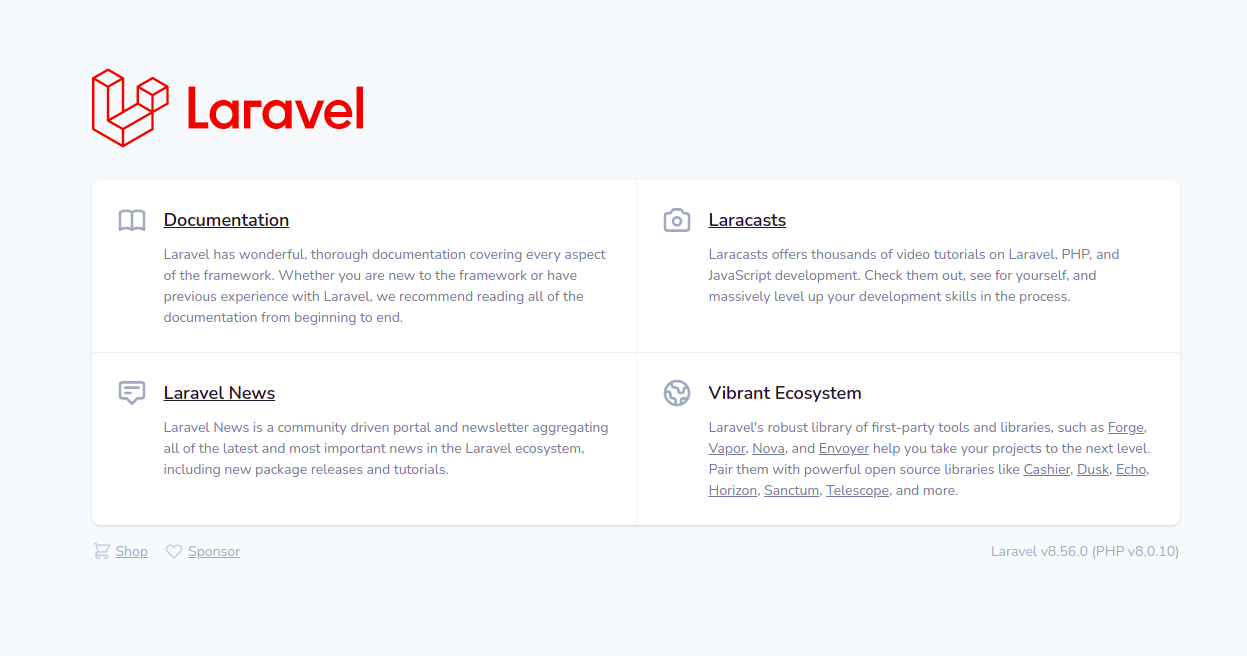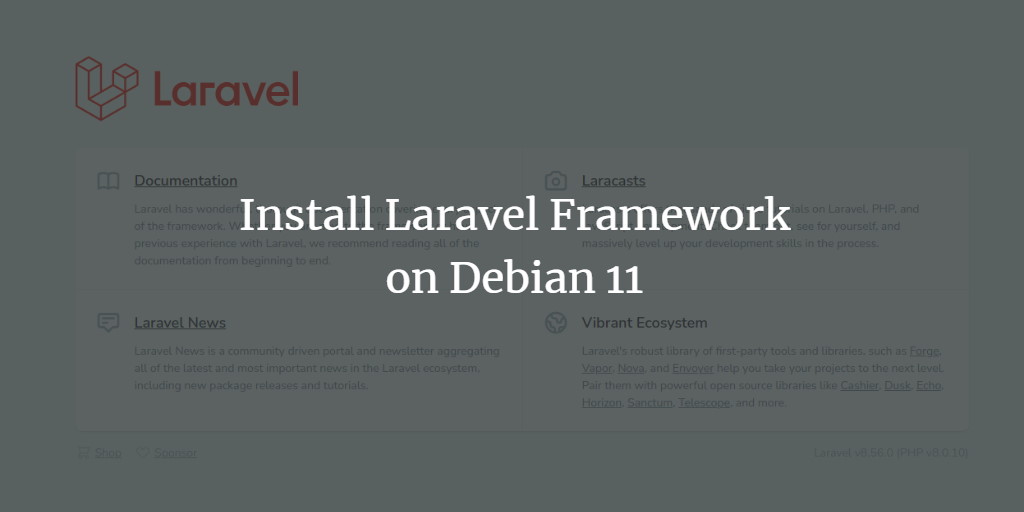Laravel is a robust, open-source PHP web framework that simplifies web application development by building on the Symfony framework. With its intuitive features, Laravel streamlines tasks like authentication, routing, sessions, and caching. Key features include Artisan, Object-Relational Mapping, Template Engine, MVC Architecture, Unit Testing, and a Database Migration System.
In this guide, we’ll walk you through installing Laravel on a Debian 11 server.
Prerequisites
- A server running Debian 11.
- A valid domain name linked to your server’s IP address.
- A root password configured on the server.
Step 1: Install Apache Web Server
Initiate the installation of the Apache package with the following command:
apt-get install apache2 -y
After the Apache installation, verify its version with:
apache2ctl -v
You should expect the following output:
Server version: Apache/2.4.48 (Debian) Server built: 2021-08-12T11:51:47
Step 2: Install PHP and Required Extensions
You’ll need PHP and additional extensions for Laravel. Start by installing the dependencies:
apt-get install apt-transport-https gnupg2 ca-certificates -y
Next, add the GPG key and PHP repository:
wget -O /etc/apt/trusted.gpg.d/php.gpg https://packages.sury.org/php/apt.gpg sh -c 'echo "deb https://packages.sury.org/php/ $(lsb_release -sc) main" > /etc/apt/sources.list.d/php.list'
Update the repository and proceed with PHP installation along with required extensions:
apt-get update -y apt-get install libapache2-mod-php php php-common php-xml php-gd php8.0-opcache php-mbstring php-tokenizer php-json php-bcmath php-zip unzip curl -y
After PHP is installed, edit the php.ini file for necessary adjustments:
nano /etc/php/8.0/apache2/php.ini
Modify these lines:
cgi.fix_pathinfo=0 date.timezone = Asia/Kolkata
Save your changes, close the file, and confirm the PHP version with:
php -v
Sample output:
PHP 8.0.10 (cli) (built: Aug 26 2021 16:06:19) ( NTS )
Copyright (c) The PHP Group
Zend Engine v4.0.10, Copyright (c) Zend Technologies
with Zend OPcache v8.0.10, Copyright (c), by Zend Technologies
Step 3: Install Composer
Composer, the PHP dependency manager, can be installed using:
curl -sS https://getcomposer.org/installer | php
Sample output:
All settings correct for using Composer Downloading... Composer (version 2.1.6) successfully installed to: /root/composer.phar Use it: php composer.phar
Move the Composer binary to your system’s path:
mv composer.phar /usr/local/bin/composer
Verify the Composer version:
composer --version
You should see:
Composer version 2.1.6 2021-08-19 17:11:08
Step 4: Install Laravel
Navigate to the Apache webroot and use Composer to download Laravel:
cd /var/www/html composer create-project --prefer-dist laravel/laravel laravel
Expected output:
> @php artisan package:discover --ansi Discovered Package: facade/ignition Discovered Package: fruitcake/laravel-cors Discovered Package: laravel/sail Discovered Package: laravel/sanctum Discovered Package: laravel/tinker Discovered Package: nesbot/carbon Discovered Package: nunomaduro/collision Package manifest generated successfully. 76 packages you are using are looking for funding. Use the `composer fund` command to find out more! > @php artisan vendor:publish --tag=laravel-assets --ansi No publishable resources for tag [laravel-assets]. Publishing complete. > @php artisan key:generate --ansi Application key set successfully.
Set appropriate permissions and ownership:
chown -R www-data:www-data /var/www/html/laravel chmod -R 775 /var/www/html/laravel
Proceed to the final configuration steps.
Step 5: Configure Apache for Laravel
Create an Apache virtual host configuration for Laravel:
nano /etc/apache2/sites-available/laravel.conf
Add this configuration:
<VirtualHost *:80>
ServerName laravel.example.com
ServerAdmin admin@example.com
DocumentRoot /var/www/html/laravel/public
<Directory /var/www/html/laravel>
Options Indexes MultiViews
AllowOverride None
Require all granted
</Directory>
ErrorLog ${APACHE_LOG_DIR}/error.log
CustomLog ${APACHE_LOG_DIR}/access.log combined
</VirtualHost>
Save the file, then enable the virtual host and rewrite module:
a2enmod rewrite a2ensite laravel.conf
Restart Apache to apply changes:
systemctl restart apache2
Check the status of the Apache service:
systemctl status apache2
You should see:
? apache2.service - The Apache HTTP Server
Loaded: loaded (/lib/systemd/system/apache2.service; enabled; vendor preset: enabled)
Active: active (running) since Fri 2021-08-27 06:00:25 UTC; 7s ago
Docs: https://httpd.apache.org/docs/2.4/
Process: 14020 ExecStart=/usr/sbin/apachectl start (code=exited, status=0/SUCCESS)
Main PID: 14025 (apache2)
Tasks: 6 (limit: 2341)
Memory: 13.2M
CPU: 97ms
CGroup: /system.slice/apache2.service
??14025 /usr/sbin/apache2 -k start
??14026 /usr/sbin/apache2 -k start
??14027 /usr/sbin/apache2 -k start
??14028 /usr/sbin/apache2 -k start
??14029 /usr/sbin/apache2 -k start
??14030 /usr/sbin/apache2 -k start
Aug 27 06:00:25 debian11 systemd[1]: Starting The Apache HTTP Server...
Step 6: Access Laravel
Launch your browser and visit http://laravel.example.com to view the Laravel welcome page:

Conclusion
Congratulations! You’ve successfully installed Laravel with Apache on Debian 11. You can now begin developing applications with the Laravel framework. If you have any questions, feel free to reach out.
Frequently Asked Questions
Why should I use Laravel?
Laravel offers a clean and elegant syntax, streamlining common web development tasks like authentication, routing, sessions, and caching.
Can I follow this guide if I’m using a different Debian version?
This guide is tailored for Debian 11. While it might work on other versions, adjustments could be necessary for compatibility.
What if I encounter issues using Composer?
Ensure you have a stable internet connection and refer to the official Composer documentation for additional troubleshooting tips.
How can I secure my Laravel installation?
For enhanced security, consider using HTTPS, regularly updating your software, and following Laravel’s security guidelines.
